
I have heard this story before, but feeling the history where it happened from the people it happened to brings a new kind of power and shame.
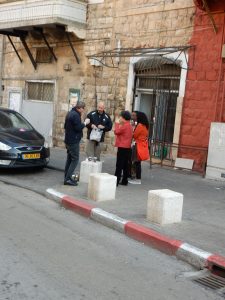
Walking through Haifa after a quick “picnic” breakfast of hot dough with za’atar and cheese and spinach, Jihad Jaburaya explains that before 1948, 70,000 Palestinians lived in the city. It was a major commercial center and workers were attracted from other Arab countries. We stop for coffee but the shop keeper refuses to charge us, Arab hospitality for visiting guests.
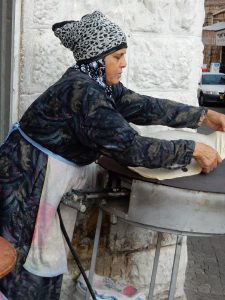
In 1948, after the barrel bombs rolled down from the hills of Carmel and the forced expulsions drove inhabitants “into the sea” where the lucky ones were able to reach Lebanon, (raising the obvious question, who exactly drove whom into the sea???) there were 1,200 Palestinians left.

The Israelis declared their homes “absentee property” and herded the remnants of the population into a prison like ghetto called Wadi Al Nasnas. I listen while my eyes wander over the discordant view of a city heavily decorated with strings of lights, an enormous Christmas tree and dove, and a whole flock of lost Santas. In 1948, the property seizures included the Islamic wafq which is supposedly protected under Islamic law for families to use.
Wadi Al Nasnas became the center of Palestinian cultural life, including the home of the famous poet Mahmoud Darwish, who fled his destroyed village of al-Birwa in the Galilee and ultimately come to Haifa. The population of 40,000 Palestinians is now like a city within a city, contradicting Haifa’s claim to be a “center of coexistence.” Most Jewish Israelis live separately from their Palestinian “neighbors” through the forces history, culture, economics, and unwritten policies including the refusal of banks to give mortgages to Palestinians in certain neighborhoods. The schools are also segregated, although the Palestinian children are taught the usual Zionist curriculum, devoid of Palestinian history, the Nakba, Arabic poetry, etc., even in their segregated schools per Israeli law. Jihad explains that when he bought a home in a nicer area, he was charged $15,0000 more than a Jewish Israeli and when he moved into the upscale property, he was told that he was not allowed to speak to any of the future owners until the property was entirely sold. His Arabic would bring down the property values and potentially ruin the neighborhood. For whom exactly?

We wander by very traditional stone Arabic homes with graceful arches in the El Hadar neighborhood, formerly a downtown Palestinian area. While many of the street names have been changed to rabbis or famous Jewish fighters, the remaining Arab names are largely Palestinian collaborators. Beyond, there are the magnificent steeply rising hills covered in upscale (read Jewish) housing.

The neighborhoods drift toward increased shabbiness with abandoned and crumbling properties as we head, stumble, clamber downhill towards the water. Jihad explains that when the Palestinian properties were seized, they were put under Israel governmental “companies” that then collected rent from the former owners. Through social media Jihad and his fellow activists are tracking down the original owners and exploring the possibilities of returning properties to these pre-’48 title holders.
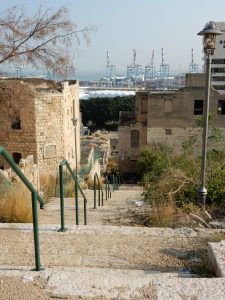
He patiently explains that it is against international law to sell or renovate the properties of people who have been expelled. In fact the rent and sales from their “state property” rightfully belong to the original owner. “This is the challenge. Are we going to buy our brothers’ houses or leave them to [Jewish] Israelis to buy? We want to highlight this. There was wealth here. The Jews wanted to buy here because of the Oriental flavor [which was very popular].” He also notes that rampant drug use was allowed and the Israeli authorities only cracked down 15 years ago when it began affecting their own sons and daughters.
We spot magnificent old houses surrounded by barbed wire, or with windows and doors boarded up (to prevent return), porches crumbling, or the lower floors date back hundreds of years but there are new spiffy upper floors and large windows. Walls are crumbling, grass and shrubs cling to cracks in the stone and window ledges.
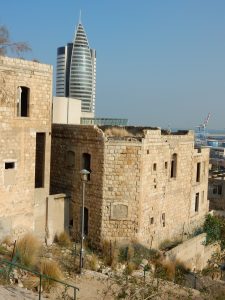
Stairways fragment and garbage tumbles everywhere. We are on the cusp of gentrification and beyond us looms the gigantic port, immense blue cranes, oil tankers, and cargo containers piled like blocks, a vast multistory glass missile shaped architectural monster, a governmental building, rises up out of the court house which is shaped like a ship with huge glass wings as if coming in from the first world bringing justice to the savages in the Levant.

In this neighborhood with the long cascade of stairs and in an old crumbling building, Jihad and his friends held their first Israeli Apartheid week. They cleaned the place up, set up banners and educational materials, and reclaimed the invisible but really quite obvious history, if you choose to see it.

As we walk along, Jihad is constantly taking photographs, videos, posting on Facebook, reaching out to the refugees in the diaspora, the cities and refugee camps.

He finds that an old man in Lebanon or a refugee in the Gulf recognizes a house, a doorway, a street and responds and thus the connections are being made and the missing links in the chain of lost human history reassembled.

It is thrilling, exhausting, time consuming work. Ironically, the street was originally called Iraq Street but it is now Shivat Zion (Return to Zion) located even more ironically in Justice Neighborhood.

I join Hazar in her car as we now head towards Akko, stopping on Barbur Corig (Sand Gardens) bridge. Below us is an expanse of green, a circular dirt pathway, and a jumble of tin roofed houses, cars, trucks, boats, chickens, and other flimsy structures. This is the remnant of an unrecognized village, repeatedly expelled since 1948. The younger generations have left and only the parents and grandparents remain, (all Israeli citizens!). Several young men gallop below on horses, their tails flying.
Ten families are “official residents” and own the land and 45 families are their illegally, so only some folks have electricity and water. The entry to this village is a dirt road hidden near the snazzy new bridge. This was once part of Akko and Hazar remembers going to school with children from this area and playing in their fields. Railroad tracks mark the other side of the property and the nearby river has dried up. Israeli authorities are planning to build a high rise here with a highway dividing whoever remains. She states emphatically, “This neighborhood is a pure visual example of apartheid.”
Looking over the bridge, Akko stretches gracefully into the sea. Napoleon Hill can be seen to the right where there is an easily visible horse sculpture. In 1799, Napoleon’s dreams of colonialism were halted by his inability to enter Akko which was then part of Lebanon.
As we drive into the City of Akko the first impression is one of enormous old stone walls, eight to fifteen meters tall, facing out to the sea, built in the 1700 and 1800s.
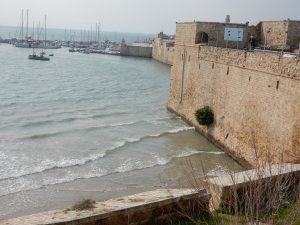
Hazar reviews the history of the last few hundred years, the various invasions and wars, and the homes that were built inside of these walls and interwoven with huge plazas and marketplaces, winding stone streets, souqs, mixed with the smells of the sea and freshly caught fish. As a child, Hazar swam at this beach and played in the Old City.
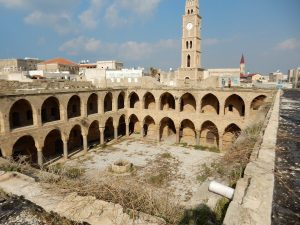
We have come to visit Umm Ahmed who is not at home, but we are greeted by her daughter Huda. In the name of progress and gentrification, this family is one of forty slated for evacuation despite the fact that these walls and homes are part of the Islamic wafq, Al Jazar, established in 1775.

We march up the irregular stairs to meet Huda, a lovely elegant woman in a black hijab who invites us in for drinks and discussion with her family members in their spacious living room.

“We will not be moved out. Here she (Umm Ahmed) had ten boys and developed a community in Akko. They are trying to dispel us. We activists are opposing this political and ethnic cleansing.” We creep up ladders to her roof to admire the spectacular view of the sea, the walls, the adjacent Al Burj mosque, the nearby cinema closed in the 1980s, and the jumble of weeds in the garden she is no longer permitted to plant. We learn of the private libraries, pianos, carpets, and artwork that were all stolen in 1948. There has been no restitution.
Returning to the family conversation, with a weird mix of soap ads, sexy dancing ladies advertising Blob Wax, and a violent soap opera playing on the TV behind us. I admire the traditionally carved cabinets, the decorative plates, oriental rugs. We learn that the Israeli authorities started looking at their older documents and discovered that there is a 36 square meter “neglected room” in their home and they are now claiming that the family owes “back taxes” of $35,000. The family has lived here for 50 years. One of the relatives says that in 1967 the family was evicted from a previous home, so when they moved into the wafq they truly understood the meaning of eviction. Payment for the home was divided between the previous owner and the wafq; this is actually the property of the mosque and should be protected. It can be inherited through only one generation by law.
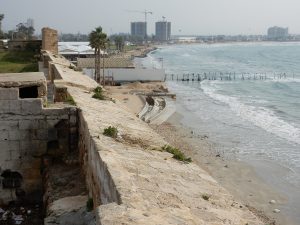
But when the Israelis first occupied the city they placed all the “absentee property’ including the mosque into the Akko Developmental Company which is now responsible for all wafq property. There is a lot more conversation but one more outrageous harassment catches my attention. The 70 year old Umm Ahmed is now having problems with her national insurance. Apparently she is being told that she is no longer eligible for national payments that she has been receiving (sounds a bit like social security) because she owns property. The authorities are attacking her from all sides. Others have been threatened with eviction because authorities want to build a hotel in this area as gentrification and dispossession continue their ugly progress. I glance at the TV and there is some kind of raging fire. It feels strangely appropriate.
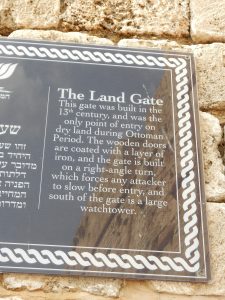
We continue our tour of Akko walking through Khan Elshawarah built in 1749. There are markets and hotels, and a tower that dates back to the Crusaders who passed through and did their thing. The open space was developed by the Akko Development Company and became a popular spot for Palestinians to enjoy. Now the company wants to evict the local families and build a 67 room hotel. Tourists in horse drawn carts with raucous music clomp by, young Israelis pose for photos, markets sell “Israelified” Palestinian food, including (shocking even to me) kanafe! The historic signage glaringly omits any Palestinian presence in the city but acknowledges the Crusaders and the Ottomans.
There is a long history that Hazar reviews. We stop at a hotel, Columns Khan, another part of the wafq which was built in 1779 for travelers to come and sell their products. The metal doors are now locked and the area is empty.

In the 1890s and during the British Mandate, Akko was part of a central commercial center that then moved to Haifa. Palestinians came to live in the wafq and had a supportive community until 1967 when the Israeli government kicked them out as part of a new Judaization project.
While Akko used to be a major port city, after 1948 the Israelis discouraged the fishing industry with high taxes for docking ships, the use of large nets with larger vessels, as well the consequences of the pollution of the water. The city turned to tourism and a Zionist version of the past.

We stop at a fresh fish market where we pick out our lunch and then go upstairs to a loud and lively restaurant where the fresh fish is served, freshly cooked. We sit out on the quiet balcony, staring at the ocean and the meowing cats who are also hoping for a bite. After a veritable flood of tasty salads arrive, the fish appears, perfectly flavored and hot, and we savor this moment in an ancient city, dating back to the Phoenicians, fortified by the Ottomans, designated as a UNESCO site, and now at the crossroads of gentrification, Judaization, and a group of activists who refuse to be forgotten.